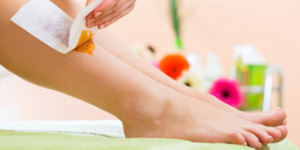Waxing Procedures
Here you will learn:
Techniques
Tools
Supplies
Procedures
The results of learning this module will be that you will be able to identify all the supplies needed for waxing; name the different methods of hair removal; know the areas of the body to be waxed; have a good knowledge of Hot wax; and have a good knowledge of Strip Wax.
Three Methods of Hair Removal
Mechanical – shaving, tweezing and waxing.
Depilatory – Pastes and crèmes
Electrical – Destruction of hair root with an electrical current eg: Electrolysis and Laser treatment.
Before commencing waxing there are six important points to remember to check for:
- Any Inflammation
- Sunburn
- New Scars
- Moles
- Rashes
- Varicose Veins
Areas to be waxed
- Legs
- Bikini Line
- Arms
- Underarms
- Stomach
- Face
- Top Lip
- Chin
- Shape Eyebrows
There are only two types of wax available. The first and most popular is warm wax known as Strip Wax. This is a quick, clean and convenient wax used mostly on the legs and arms. Strip Wax is applied in a very thin layer with a spatula and removed by using a piece of material.
The second type of wax is Hot Wax. This type of wax is a more gentle wax used on the bikini line, underarms and face. Hot wax doesn’t leave the affected area as red as strip wax. Hot wax is applied quite thick by using a wooden (disposable) spatula and is removed with a ‘pick and flick’ action by lifting an edge and then pulling the wax off in strips.
Health Regulations: Wax must not be re-used, but rather discarded after use.
Preparation for Waxing
Make sure that you have the following items ready before your first client arrives.
- Waxpot
- Wooden Board
- Spatula
- Waste Container
- Tissue / Cotton Wool
- Oil / Powder
- Disinfectant
- Apron
- Soothing Lotion
Procedure for Hot Wax
- Wash Hands – Anti-Bac
- Check contra-indications
- Disinfect area
- Apply powder or oil
- Test wax temperature on yourself
- Using a wooden spatula, apply wax in direction of hair growth
- Knead – flick end of wax and remove quickly
- Apply soothing lotion
- Wash hands
- Discard all spatulas and wax used
- Clean working area
Procedure for Strip Wax
- Wash Hands – Anti-Bac
- Check contra-indications
- Disinfect area
- Test wax temperature on yourself
- Using a metal spatula, apply wax in direction of hair growth
- Press cloth strips over wax
- Remove quickly, against growth of hair
- Apply soothing lotion
- Wash hands
- Clean and disinfect spatula
- Clean working area
There are two very important points to remember when waxing:
- Always apply the wax in the direction of the hair growth. When removing the wax, remove in the opposite direction – against the growth.
- It is essential to disinfect before and after waxing to ensure there is no infection.
Important Points on Waxing
Never wax over broken skin or moles of any type.
Avoid waxing repeatedly on face – once is enough. Tweeze the stray bits out.
Do not wax the face if your client is on skin medication.
If your client comes out in mosquito type spots – do not use a wooden spatula. Make sure you have a metal spatula handy.
Never apply Vasoline or tea-tree oil after waxing.
Equipment List
You will need the following products and equipment to run your new Waxing service:
2 x Wax Pots (One for Hot Wax, one for Strip Wax)
Metal and wooden spatulas
Tongue Depressors
Facial Wax applicators (wooden sticks like paddle-pop sticks)
Wax cleaner
Clean Towels
Beauty Gowns
Operators Apron
Strip Wax – ‘Brilliance’ by Caron has an anaesthetic ingredient in it to make waxing less painful for the client
Calico Roll or cut strips or Super Wax Strips
Hot Wax – Once again, use ‘Brilliance’ by Caron for less painful waxing
Pre Wax Lotion
After Wax Lotion
Hair Retardant crème
Tissues
Cotton Wool
Disinfectant
Therapists Bed
Mag Lamp
Waste Container

Monitor Closely 1 sotalol and isradipine both increase anti hypertensive channel blocking priligy pill
There were 113 African American and 67 Mexican American cases with newly diagnosed, previously untreated lung cancer and 270 controls, frequency matched on age, ethnicity, and sex cost of cytotec without a prescription
ginseng are called ginsenosides, which show both stimulatory and inhibitory activity in animal nervous systems clomid where to buy